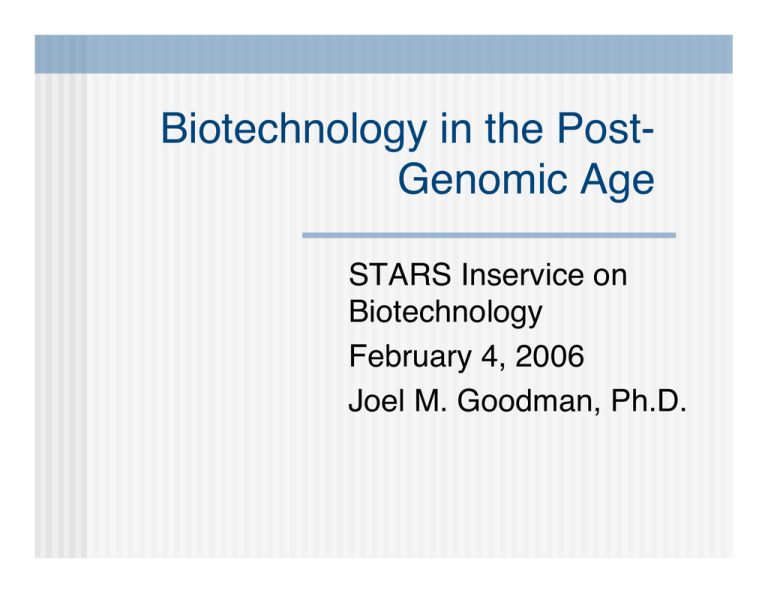Biotechnology in the Post- Genomic Age STARS Inservice on Biotechnology
advertisement

Biotechnology in the PostGenomic Age STARS Inservice on Biotechnology February 4, 2006 Joel M. Goodman, Ph.D. Supporting Cast STARS support Ms. Jeannie Han Ms. Traydell Beard Goodman lab support Dr. Derk Binns Ms. Kimberly Szymanski Activity 1: PCR We’ll start this now, talk more later You will be amplifying a yeast gene (one of five different genes) using the polymerase chain reaction. 6 groups, 4 teachers to a group By the end of the day, you will identify which gene you have amplified DNA PCR figs from http://www.lshtm.ac.uk/pmbu/staff/rmcnerney/homepage/basicstext.html DNA melting Annealing of “oligos” Strand elongation “A” is really Deoxyadenosine triphosphate, or dATP PCR cycle 1 “template” (genomic DNA) Primers used dXTPs, Polymerase used PCR cycle 2 PCR cycle 3 PCR exercise You will amplify your gene through 30 cycles of primer annealing, elongation, and melting Reagents: Template: yeast DNA Primers: ends of genes, ~20 bases Heat-stable Polymerase (Vent ®) Nucleotides (building blocks for polymerase) Buffer Today’s Aims You will focus on five genes from bakers’ yeast (Saccharomyces cerevisiae) You will be assigned one of these, the identity unknown to you You will identify it based on its PCR product and its phenotype Activities Perform PCR to amplify your gene Become familiar with the Saccharomyces cerevisiae Genomic Database, SGD (www.yeastgenome.org) Learn about the six genes and phenotypes of the corresponding gene disruptions Based on PCR and phenotype, identify your gene Schedule Morning Prepare PCR reaction, start cycling Introduction to SGD and strain library Sleuthing SGD of 6 genes Lunch Afternoon Loading PCR products on gel Innoculating plates with yeast strains Determining migrations of PCR products Determining your mystery gene Saccharomyces cerevisiae Bakers yeast Budding yeast 7 µm diameter Haploid or diploid Cell wall Contains 6600 genes wallhttp ://www.sb -roscoff.fr/C yC ell/Images/yeast1.jp g Yeast as a Model Organism Cell Biology simpler than mammalian cells Signal Transduction Molecular Genetics DNA/RNA metabolism Finding mammalian orthologs in disease Study of mutants easy wallhttp ://www.sb -roscoff.fr/C yC ell/Images/yeast1.jp g Yeast is NOT good for Many cell-cell interactions Cell specializations Developmental biology Stem cell research wallhttp ://www.sb -roscoff.fr/C yC ell/Images/yeast1.jp g The yeast genome: 6604 ORFS 1417 ORFS 820 ORFS 4367 ORFS ORF = Open Reading Frame What does gene X do? You are studying a human gene. Cells difficult to manipulate. Find yeast ortholog and mutate What genes are involved with process X? What genes interact with your favorite gene? Yeast deletion libraries By PCR, and homologous recombination, every gene has been “knocked out.” Homologous recombination Openbiosystems.com Yeast deletion libraries By PCR, and homologous recombination, every gene has been “knocked out.” You can buy a “knock-out strain” for about $50 each. You can buy an ENTIRE library of strains for $1500. Only non-essential genes can be knocked-out in haploid cells; essential genes can be knocked out in diploids (one normal copy still present) Lipid body phenotypes Normal Phenotype Big Lipid Bodies “Starry Night” Small Lipid Bodies Kim Szymanski First step: PCR You will be assigned a deletion strain, missing one of 5 genes You will be given oligos to your assigned gene You will run a PCR reaction In the afternoon, you will analyze the PCR product by agarose gel electrophoresis against standards. Second Step: yeastgenome.org The yeast genome was the first eukaryotic genome to be sequenced (~1993) Stanford University assembled this database Constantly being improved and updated Comparatively easy to navigate Sleuthing SGD for clues Gene Function; which pathway? Phenotype of null mutant Which chromosome? Watson or Crick strand? # of bases Location of protein Why named? Other interesting stuff ADE2 CKB1 GAL1 SIW14 TRP1 Third step: Phenotypes The phenotype of null mutants is very useful to obtaining clues as to function of the gene Cell morphology, growth, organelle movement and morphology protein trafficking, etc. You will be given agar plates to innoculate with your mutant strain You will determine the extent of growth on those plates and choose which of the five genes is missing. Translation to the Classroom Exercises with a genome database Polymerase chain reaction (PCR) Sleuth for information on gene and protein Many schools have PCR machines, STARS has one available PCR kits, PCR not required Deletion library Phenotype observations - Plates easy to make, students can observe different behaviors and morphologies, relate them to gene deletions







